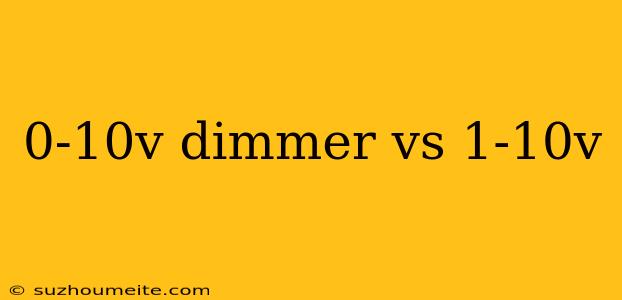0-10V Dimmer vs 1-10V: Understanding the Difference
When it comes to dimming lighting systems, two common protocols used are 0-10V and 1-10V. While they may seem similar, these two protocols have distinct differences in their operation, application, and compatibility. In this article, we will delve into the details of 0-10V dimmer vs 1-10V, highlighting their advantages, disadvantages, and use cases.
What is a 0-10V Dimmer?
A 0-10V dimmer is a type of analog dimming protocol that uses a 0-10V DC voltage signal to control the brightness of a lighting fixture. The dimmer output ranges from 0V (minimum brightness) to 10V (maximum brightness). The 0-10V signal is typically sent from a controller or a wall dimmer to the lighting fixture, which adjusts its brightness accordingly.
Advantages of 0-10V Dimmer:
- Wide compatibility: 0-10V dimmers are widely supported by most LED drivers and fluorescent ballasts.
- Simple installation: 0-10V dimmers require only two wires for control, making installation straightforward.
- Cost-effective: 0-10V dimmers are generally less expensive than 1-10V dimmers.
Disadvantages of 0-10V Dimmer:
- Limited scalability: 0-10V dimmers are not suitable for large-scale lighting systems due to voltage drop issues.
- Noise susceptibility: 0-10V signals can be prone to electromagnetic interference (EMI) and radio-frequency interference (RFI).
What is a 1-10V Dimmer?
A 1-10V dimmer is another type of analog dimming protocol that uses a 1-10V DC voltage signal to control the brightness of a lighting fixture. The key difference between 0-10V and 1-10V dimmers is that the latter maintains a minimum voltage of 1V, even when the lighting fixture is turned off. This ensures that the fixture remains energized, allowing for faster switching times and improved reliability.
Advantages of 1-10V Dimmer:
- Faster switching times: 1-10V dimmers can switch lighting fixtures on and off more quickly than 0-10V dimmers.
- Improved reliability: The minimum 1V voltage ensures that the lighting fixture remains energized, reducing the risk of faulty switching.
- Better noise immunity: 1-10V signals are less susceptible to EMI and RFI.
Disadvantages of 1-10V Dimmer:
- Limited compatibility: 1-10V dimmers may not be compatible with all LED drivers and fluorescent ballasts.
- More complex installation: 1-10V dimmers often require additional wiring and components, making installation more complicated.
- Higher cost: 1-10V dimmers are generally more expensive than 0-10V dimmers.
When to Use 0-10V Dimmer vs 1-10V Dimmer
When deciding between a 0-10V dimmer and a 1-10V dimmer, consider the following factors:
- System size and complexity: For small to medium-sized lighting systems, 0-10V dimmers are often sufficient. Larger systems may benefit from the increased reliability and noise immunity of 1-10V dimmers.
- Lighting fixture type: 0-10V dimmers are suitable for most LED drivers and fluorescent ballasts. However, if you're using specialized lighting fixtures that require a minimum voltage to maintain energization, 1-10V dimmers may be a better choice.
- Budget and installation complexity: If cost is a significant factor, 0-10V dimmers may be a more attractive option. However, if you're willing to invest in a more complex installation for improved performance, 1-10V dimmers may be the better choice.
In conclusion, while both 0-10V and 1-10V dimmers have their advantages and disadvantages, understanding the differences between them is crucial for selecting the right dimming protocol for your lighting system. By considering system size, lighting fixture type, and budget, you can make an informed decision that meets your specific needs.
